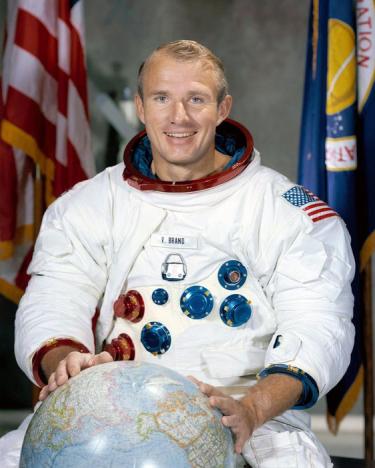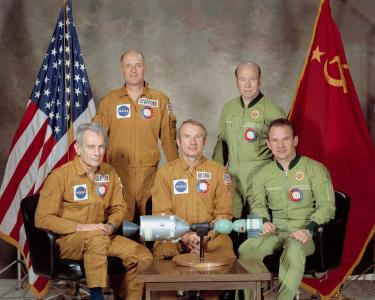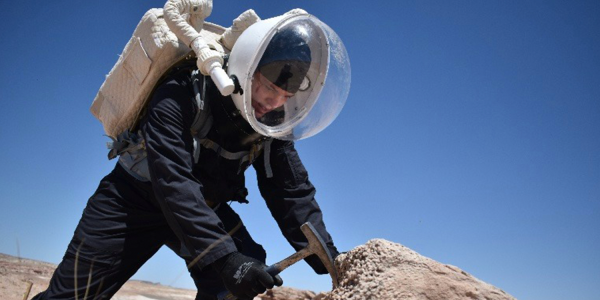 Forty-five years ago, Vance Brand made history when he and his Apollo crew members met with Soviet cosmonauts in space, only to narrowly survive a near-fatal landing back on Earth.
Forty-five years ago, Vance Brand made history when he and his Apollo crew members met with Soviet cosmonauts in space, only to narrowly survive a near-fatal landing back on Earth.
In the midst of the Cold War between the United States and Soviet Union that spurred the costliest arms race in human history, Vance Brand (Bus’53, Aero’60) casually lunched with two Soviet cosmonauts 140 miles above Earth.
Below them, thousands of American soldiers were adjusting to life back in the United States after the fall of Saigon to communists two months earlier. Fear of communism’s spread across the globe was palpable. The only thing possibly more momentarily terrifying was Steven Spielberg’s thriller Jaws , which had just hit movie theaters.
 Brand had flown for nearly two days with two other Americans on the Apollo spacecraft to dock to the Soviets’ Soyuz spacecraft for the first time ever. When they boarded each other’s ships on July 17, 1975, it was televised in both the Soviet Union and the United States. The Apollo-Soyuz mission was celebrated as both an engineering feat and a diplomatic victory, both countries overcoming years of mistrust to collaborate on an international space flight.
Brand had flown for nearly two days with two other Americans on the Apollo spacecraft to dock to the Soviets’ Soyuz spacecraft for the first time ever. When they boarded each other’s ships on July 17, 1975, it was televised in both the Soviet Union and the United States. The Apollo-Soyuz mission was celebrated as both an engineering feat and a diplomatic victory, both countries overcoming years of mistrust to collaborate on an international space flight.
But the rendezvous was also the result of the U.S. and Soviet Union acknowledging a cold reality — they actually needed each other in space, even as they threatened each other with nuclear war on Earth. Forty-five years later, many argue that the mission lay the groundwork for the collaboration with the Russians on the International Space Station, which continues today.
“When the movie Marooned came out in 1969 with actor Gregory Peck, it involved an American capsule that was stuck in space and the Soviets were involved in the rescue,” said Bill Barry, NASA’s chief historian. “President Nixon saw it in the White House and so did the Soviets. The idea that there were two countries flying in space with two incompatible modules nudged the mission. The idea was if we could rescue each other in space, it would be good.”
For the next four years, the two countries worked together intensely to create a docking system that would enable two very differently built spacecraft to join together. Brand and his crew members studied Russian while their Soviet compatriots studied English to ensure they could communicate while in space. But few things prepared Brand for his first training visit to the Soviet Union.
“You have to remember the situation in the world was completely different,” Brand said. “We were in the Cold War and it was at its peak. I hoped the Soviets were friendly. As I stepped out of the plane, you could tell they were all for the mission. There were little kids with flowers running up to us and a big crowd there.”
According to Brand, one of the most fascinating things about space is the views of Earth.
 Once in space, the Apollo and Soyuz spacecraft docked without a hitch. President Gerald Ford and Soviet Communist Party General Secretary Leonid Brezhnev called to congratulate the crews. The astronauts and cosmonauts exchanged gifts and food and conducted more than 28 experiments, including five jointly with the Soviet crew.
Once in space, the Apollo and Soyuz spacecraft docked without a hitch. President Gerald Ford and Soviet Communist Party General Secretary Leonid Brezhnev called to congratulate the crews. The astronauts and cosmonauts exchanged gifts and food and conducted more than 28 experiments, including five jointly with the Soviet crew.
But when Brand and his crew descended 50,000 feet above Earth, things took a dramatic turn for the worse. During the last seconds of the mission, near-fatal amounts of toxic gas from the thrusters outside the craft got into the Apollo cabin. After the crew splashed down in the Pacific Ocean 375 miles from Hawaii, Brand passed out for a minute from the gas until a crew member put an oxygen mask on him. All three crew members were hospitalized for two weeks afterward.
That splashdown marked the end of an era. It was the last Apollo mission. And despite all the goodwill and cooperation fostered between the Soviets and Americans, the Cold War got colder. Nineteen years passed before the two countries joined together on a human spaceflight mission.
After the historic rendezvous, Brand went on to command three space shuttle missions, including flying on the Challenger when the crew did the first untethered space walks in 1984. Retired since 2008, he said one of the most fascinating things about space is the views of Earth. Oftentimes, you can spot landmarks not by their recognizable features but by something else — shadows and contrasts.
“When you’re up there, you only have a few seconds or part of a minute to see what you’re looking for,” Brand said. “For example, I could see the road clearly from Cairo to the pyramids because there was vegetation along the road and everything else was desert. I remember looking for the pyramids, and I could just see their shadows.”

Vance Brand and his family donated 40 acres of his property to Rocky Mountain National Park.
Longs Peak, which dominated his views growing up in Longmont, Colorado, was harder to make out from space. Brand climbed the 14,259- foot peak in Rocky Mountain National Park as a Boy Scout and spent summers in high school and at CU Boulder exploring the park. When he was 36, he bought 160 acres of pristine land next to it.
The park’s extraordinary beauty led him to make headlines at the end of 2019. Brand and his family donated 40 acres of his property to Rocky Mountain National Park. With his legacy tethered to space, a place visited by so few, his gift to the national park is something that can be enjoyed by so many — in 2019, 4.6 million people visited the park.
“In my younger days, I felt like I got a lot from the park,” the 89-year-old said from his home in California. “It’s a terrific national asset. We’re getting so much urban sprawl, even since I was wandering around Rocky Mountain National Park as a young man. There’s something to be said for the preservation of nature in some places.”
Photos courtesy The NASA Library / Alamy Stock Photo (Bottom)





